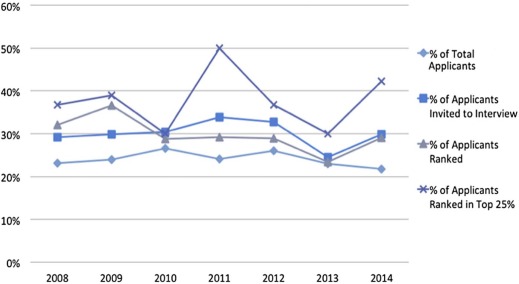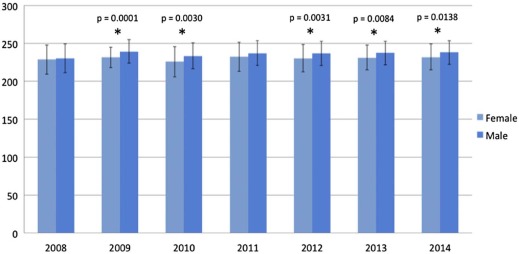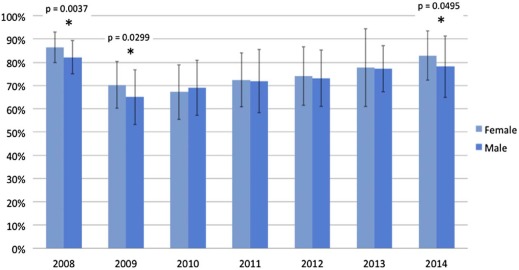Rationale and Objectives
To investigate whether there is a bias in the residency selection process that influences the proportion of females entering diagnostic radiology residencies.
Materials and Methods
A total of 4117 applications to one diagnostic radiology residency program from 2008 to 2014 were analyzed. Invitations to interview were evaluated by each year, specifically looking at gender. Ranking of applicants, especially those placed in top 25% of the rank, was also assessed. Additional data analyzed included United States Medical Licensing Examination Step 1 board examination score (a proxy for academic performance), interview scores, and final position on rank list.
Results
Female applicants averaged 24% of the total applicant pool during the years studied, yet made up a disproportionately high percentage of applicants invited to interview (30%) and those ranked in top 25% (38%). It was found that female applicants had slightly higher mean interview scores and lower Step 1 scores than male applicants.
Conclusions
Our findings suggest that program directors in one program want to increase gender diversity by making strides to keep the female candidate pool and the proportion of female residents in the program at least stable. The pipeline of female medical students pursuing a career in radiology appears to be a limiting factor rather than a bias against women in the resident selection process. Identifying such trends is important as it provides a better understanding of the etiology for an overall lack of gender diversity within the field. Furthermore, it may lead to closing the gender gap in radiology.
Introduction
Although the percentage of women graduating from medical schools in the United States has increased significantly in the last few decades, reaching almost 50% in 2007, there has not been a parallel increase in gender composition of medical graduates pursuing diagnostic radiology residency programs . The proportion of women starting a career in radiology has remained remarkably stagnant since at least 1980, when 25.5% of all radiology residents were female . As of 2013, women made up just 26.8% of all the radiology residents, demonstrating only a 1.3% increase in more than 30 years . Conversely, the gender landscape in other specialties has changed significantly during this same period of time. In the 1980s and prior, female residents were concentrated in internal medicine, obstetrics and gynecology, pediatrics, and family medicine . Since then, women have redistributed throughout most other specialties, even those that are historically male predominant such as surgery and the various surgical subspecialties . Radiology has not benefitted from this redistribution of women in medicine, as evidenced by the fact that the proportion of women in the specialty has not significantly changed.
The reason women continue to be underrepresented in radiology has been studied at length, including baseline interest of medical students in radiology, factors influencing interest, and whether these factors differ between genders . Lifestyle factors and other characteristics that influence whether medical students choose radiology as a career, such as the amount of patient contact, salary, and competitiveness, have also been described in relationship to gender . The influence of female role models, program directors, and faculty in determining a female medical student’s career path has also been investigated in several articles .
Get Radiology Tree app to read full this article<
Get Radiology Tree app to read full this article<
Methods
Get Radiology Tree app to read full this article<
Get Radiology Tree app to read full this article<
Get Radiology Tree app to read full this article<
Get Radiology Tree app to read full this article<
Get Radiology Tree app to read full this article<
Get Radiology Tree app to read full this article<
Get Radiology Tree app to read full this article<
Get Radiology Tree app to read full this article<
Results
Get Radiology Tree app to read full this article<
Table 1
Distribution of Female Applicants as Percentage of Total Applicant Pool, Applicants Invited to Interview, Applicants Ranked, and Applicants Ranked in Top Quartile, 2008–2014
2008 2009 2010 2011 2012 2013 2014 Average All applicants Female 144 152 175 140 144 122 116 142 Male 480 483 485 441 409 409 417 446 % Female of total 23.1% 23.9% 26.5% 24.1% 26.0% 23.0% 21.8% 24.1% Invited to interview Female 38 31 34 38 35 33 41 36 Male 92 73 78 74 72 102 96 84 % Female of total 29.2% 29.8% 30.4% 33.9% 32.7% 24.4% 29.9% 30.1% Ranked Female 32 26 23 23 22 21 29 25 Male 68 45 57 56 54 69 71 60 % Female of total 32.0% 36.6% 28.8% 29.1% 28.9% 23.3% 29.0% 29.7% Ranked in top 25% Female 7 7 6 10 7 7 11 8 Male 12 11 14 10 12 16 15 13 % Female of total 36.8% 38.9% 30.0% 50.0% 36.8% 30.0% 42.3% 37.8%
Get Radiology Tree app to read full this article<
Get Radiology Tree app to read full this article<
Get Radiology Tree app to read full this article<
Get Radiology Tree app to read full this article<
Table 2
National ERAS Data: Number of Applicants to ACGME Radiology Residency Programs per Year by Gender
2010 2011 2012 2013 2014 Average All applicants Total 2322 2592 2637 2780 2632 2592 Female 712 830 780 826 758 781 Male 1607 1759 1856 1954 1872 1810 No answer 3 3 1 0 2 2 % Female of total 30.7% 32.1% 29.6% 29.7% 28.8% 30.2%
Get Radiology Tree app to read full this article<
Get Radiology Tree app to read full this article<
Get Radiology Tree app to read full this article<
Get Radiology Tree app to read full this article<
Get Radiology Tree app to read full this article<
Discussion
Get Radiology Tree app to read full this article<
Get Radiology Tree app to read full this article<
Get Radiology Tree app to read full this article<
Get Radiology Tree app to read full this article<
Get Radiology Tree app to read full this article<
Get Radiology Tree app to read full this article<
Get Radiology Tree app to read full this article<
Get Radiology Tree app to read full this article<
Get Radiology Tree app to read full this article<
Get Radiology Tree app to read full this article<
Get Radiology Tree app to read full this article<
Get Radiology Tree app to read full this article<
Get Radiology Tree app to read full this article<
Get Radiology Tree app to read full this article<
Get Radiology Tree app to read full this article<
Get Radiology Tree app to read full this article<
Conclusion
Get Radiology Tree app to read full this article<
Get Radiology Tree app to read full this article<
References
1. AAMC : Table 1: medical students, selected years, 1965-2013. Available at: https://www.aamc.org/download/411782/data/2014_table1.pdf
2. Frank E., Vydareny K.: Characteristics of women radiologists in the United States. AJR Am J. Roentgenol 1999; 73: pp. 531-536.
3. AAMC : Table 2: distribution of residents by specialty, 2003 compared to 2013. The State of women in academic medicine: the pipeline and pathways to leadership, 2013–2014. Available at: http://www.aamc.org/members/gwims/statistics#tables
4. Bickel J.: Gender equity in undergraduate medical education: a status report. J Womens Health Gend Based Med 2001; 10: pp. 261-270.
5. Roubidoux M.A., Packer M.M., Applegate K.E., et. al.: Female medical students’ interest in radiology careers. J Am Coll Radiol 2009; 6: pp. 246-253.
6. Vidal V., Jacquier A., Giorgi R., et. al.: Radiology as seen by medical students. J Radiol 2011; 92: pp. 393-404.
7. Fielding J.R., Major N.M., Mullan B.F., et. al.: Choosing a specialty in medicine: female medical students and radiology. AJR Am J. Roentgenol 2007; 188: pp. 897-900.
8. Reshma J., Griffith K.A., DeCastro R.A., et. al.: Sex, role models, and specialty choices among graduates of US medical schools in 2006-2008. J Am Coll Surg 2014; 218: pp. 345-352.
9. Baker S.R., Barry M., Chaudry H., et. al.: Women as radiologists: are there barriers to entry and advancement?. J Am Coll Radiol 2006; 3: pp. 131-134.
10. Meghan E.: Coming together. Prioritizing diversity isn’t just a good ethical principle—it’s good business sense. ACR Bulletin2015.
11. Nivet M.A.: Commentary: diversity 3.0: a necessary systems upgrade. Acad Med 2011; 86: pp. 1487-1489.
12. Boechat M.I.: Women in pediatric radiology. Pediatr Radiol 2010; 40: pp. 484-487.
13. Merewitz L., Sunshine J.H.: A portrait of pediatric radiologists in the United States. AJR Am J. Roentgenol 2006; 186: pp. 12-22.
14. Wing P., Langelier M.H.: Workforce shortages in breast imaging: impact on mammography utilization. AJR Am J. Roentgenol 2009; 192: pp. 370-378.
15. AAMC : What you don’t know: the science of unconscious bias and what to do about it in the search and recruitment process. E-learning Seminar1995-2010.
16. Moss-Racusin C.A., Dovidio J.F., Brescoli V.L., et. al.: Science faculty’s subtle gender biases favor male students. Proc Natl Acad Sci U S A 2012; 109: pp. 16474-16479.
17. Martell R.F., Lane D.M., Emrich C.: Male-female differences: a computer simulation. Am Psychol 1996; 51: pp. 157-158.
18. Zhang C., Rauchwarger A., Toth C., et. al.: Student USMLE Step 1 preparation and performance. Adv Health Sci Educ Theory Pract 2004; 9: pp. 291-297.
19. AAMC : Historical specialty specific data—radiology-diagnostic, ERAS 2010-2014. AAMC. Available at: http://www.aamc.org/download/359156/data/radiology-diagnostic.pdf
20. Lewis R.S., Bhargavan M., Sunshine J.H.: Women radiologists in the United States: results from the American College of Radiology’s 2003 survey. Radiology 2007; 242: pp. 802-810.
21. AAMC : Table C5: physician retention in state of residency training by last completed GME specialty and gender. Available at: https://www.aamc.org/data/420852/tablec5.html
22. Trix F., Psenka C.: Exploring the color of glass: letters of recommendation for female and male medical faculty. Discourse Soc 2003; 14: pp. 191-220.
23. Schmader T., Whitehead J., Wysocki V.H.: A linguistic comparison of letters of recommendation for male and female chemistry and biochemistry job applicants. Sex Roles 2007; 57: pp. 509-514.
24. Madera J.M., Hebl M.R., Martin R.C.: Gender and letters of recommendation for academia: agentic and communal differences. J Appl Psychol 2009; 94: pp. 1591-1599.
25. NRMP : Program director survey reports, years 2008, 2010, 2012, 2014. December 2008, May 2010, August 2012, August 2014; Available at: www.nrmp.org/match-data/nrmp-historical-reports/
26. Isaac C., Chertoff J., Lee B., et. al.: Do students’ and authors’ genders affect evaluations? A linguistic analysis of medical student performance evaluations. Acad Med 2011; 86: pp. 59-66.
27. Jolly P., Boulet J., Garrison G., et. al.: Participation in U.S. graduate medical education by graduates of international medical schools. Acad Med 2011; 86: pp. 559-564.
28. Shiroma P.R., Alarcon R.D.: Selection factors among international medical graduates and psychiatric residency performance. Acad Psychiatry 2010; 34: pp. 128-131.
29. Desbiens N.A., Vidaillet H.J.: Discrimination against international medical graduates in the United States residency program selection process. BMC Med Educ 2010; 10: pp. 5.
30. Pilotto L.S., Duncan G.F., Anderson-Wurf J.: Issues for clinicians training international medical graduates: a systematic review. Med J Aust 2007; 187: pp. 225-228.
31. AAMC : Table B2: number of active residents by type of medical school graduation, GME specialty, and gender, 2013-2014 active residents. August 21, 2014; Available at: https://www.aamc.org/data/421322/tableb2.html
32. Isaac C., Lee B., Carnes M.: Interventions that affect gender bias in hiring: a systemic review. Academic Medicine 2009; 84: pp. 1440-1446.
33. Chapman C.H., Hwang W., Both S., et. al.: Current status of diversity by race, Hispanic ethnicity, and sex in diagnostic radiology. Radiology 2014; 270: pp. 232-240.
34. Pelletier M., Belliveau P.: Role of surgical residents in undergraduate surgical education. Can J Surg 1999; 42: pp. 451-456.
35. Snyder R.A., Bills J.L., Phillips S.E., et. al.: Specific interventions to increase women’s interest in surgery. J Am Coll Surg 2008; 207: pp. 942-947.
36. Deloney L.A., Rozenshtein A., Deitte L.A., et. al.: What program directors think: results of the 2011 annual survey of the association of program directors in radiology. Acad Radiol 2012; 19: pp. 1583-1588.


